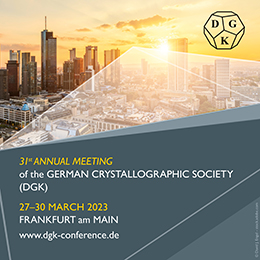


Commentary
Crystal allure: a response to Depmeier’s article
![thumbnail [thumbnail]](https://www.iucr.org/__data/assets/image/0009/155583/Thumbnail.jpg)
I would like first to thank Professor Wulf Depmeier for writing a thoughtful, informative and overly generous laudatio on the occasion of the Waltrude and Friedrich Liebau Prize for the Promotion of Interdisciplinarity in Crystallography, awarded to me by the Deutsche Gesellschaft für Kristallographie (Depmeier, 2022). Working on the frontiers between disciplines is not an easy task. It is a zone not always appreciated by evaluation panels and science programs. I like to explore that zone. I have been a fan of crystallography since I was sixteen years old, an expert who knows its powerful diffraction methods developed during the XX century, one of humankind’s most fascinating intellectual odysseys. I know about crystals, their fascinating properties, their birth and growth, and I apply this knowledge to everything I find interesting, beautiful and challenging. To be awarded for this is something unexpected that I receive with honor and happiness. I will not comment on the biographical aspects of the article except to inform the reader that the ESA headquarters announced today that the ExoMars mission that will transport the rover “Rosalind Franklin” to the surface of Mars is re-scheduled for 2028.
In addition to the laudatio, Professor Wulf Depmeier, Wulf, opens with a discussion on a couple of points I would like to comment on because it is also of interest to one of my current interdisciplinary investigations. I have devoted part of my research in recent years to studying the influence that the idea of crystals has had on art, an intellectual passion that I share with Professor Depmeier, a pioneer in this field. During my sabbatical in Germany this year, we shared many ideas and data; along with Professor Wolfgang Bach we visited the Wenzel Hablik Museum in Itzehoe, a small but historical town not far from Hamburg and Kiel, where Wulf lives. We discussed how these influences occurred at several stages of history/prehistory and what evidence we have for them.
The oldest of these influences is rooted in the earliest stages of the evolution of our minds before what we call consciousness emerged. Nowadays, it is considered that the first evidence of the symbolic thought of our species is none other than the collection of quartz and calcite crystals, a practice that started at least 780,000 years ago. There is plenty of archeological evidence for this practice, as described in the literature (García-Ruiz, 2018) and a previous article in this newsletter (García-Ruiz, 2021). In that article, I wondered if crystal morphology could be one of the reasons for the allure of crystals for our ancestors and modern humans. Professor Depmeier kindly discussed this issue in his article and proposed that another cause of the attraction of crystals for hominins could be the reflection of light by their flat faces, which is termed brightness or luster. This is an important issue because we need to know how deep in our minds is the attraction that we feel for crystals. We need to know in detail the reason(s) for the crystal allure and how it affected the development of our brain and our understanding of the world, our social relations and our beliefs. Some could consider that this kind of investigation is hardly within the limits of what we consider science (Helliwell, 2018). We should recall that, despite the absence of scientific evidence, a large percentage of the population, irrespective of educational level, gender or regional origin, believes in the healing power of crystals. Sixty percent of the sales in mineral shops are related to this belief. I think it is neither ethically correct nor wise for rational scientists to fight these feelings. However, a serious investigation of crystal allure would explain why today so many people still believe in magic crystals. My research aims to send the message “you are free to trust in the magic properties of crystals, but we can explain why you are trusting, which is the origin of that belief, and to what extent that belief is reasonable”.
There is no doubt that optical properties such as brightness and transparency are among the main reasons why single crystals could have been attractive to our ancestors. Hominins were familiar with both optical properties because water, under certain circumstances, can have them, as Depmeier perceptively suggests. In fact, the word `crystal', coined in ancient Greece to name rock crystals and other transparent minerals, means frozen water. This etymology is proof of the relevance of optical properties in the conceptual relations of early humans with minerals. The solidity of crystals would make those optical properties even more charming. Quartz and other crystals would have been the only solid objects showing high transparency and light reflection that early humans would have encountered and handled.
However, brightness (i.e. light emitted by a reflecting surface) is not a passive property of the objects but an active one. Unlike shape or transparency, the light reflected by an object unavoidably draws our attention, bothers us, disturbs our vision. It is a call that makes us pay attention to the shiny object. Mineral sellers place sparkling crystals in strategic places on their sales tables and their most valuable crystals around them because they know that customers will be attracted to the shine and stop by. The glow of crystals was undoubtedly an important property in attracting hominin attention, but probably not enough by itself to make them valuable to be collected. Last fall, I started investigations to explain the allure of crystals for hominins with the help of a group of chimpanzees, the closest apes from which we parted about six million years ago and with whom we share many genetic and behavioral similarities. The results have not yet been published, but in correspondence to the beautiful gift offered by Professor Depmeier, the painting of Ferdinand Holder “Le lac de Thoune aux reflets symetriques” I wish to share with you in his honor some frames of a couple of the videos recorded during the investigation with the cooperation of Dr. Tomás de la Rosa, Guillermo Bustelo and Aden Bart; see the figures below.
![[Figure1]](https://www.iucr.org/__data/assets/image/0010/155584/Picture1.png)
![[Figure2]](https://www.iucr.org/__data/assets/image/0011/155585/Picture2.png) Toti is shown here examining a large single crystal of quartz. That crystal was used in one of our experiments along with an irregular stone of similar size to compare their attractiveness for chimps. The two objects were exposed in the garden of the chimps on top of two pedestals. The preference for the interaction with the crystal was statistically obvious. In addition, the chimps took the crystal and transported it to their dorm, where they studied it for a couple of days until we managed to take the crystal back. Toti oriented the crystal to observe it from different angles, showing particular interest in the view parallel to the hexagonal axis.
Toti is shown here examining a large single crystal of quartz. That crystal was used in one of our experiments along with an irregular stone of similar size to compare their attractiveness for chimps. The two objects were exposed in the garden of the chimps on top of two pedestals. The preference for the interaction with the crystal was statistically obvious. In addition, the chimps took the crystal and transported it to their dorm, where they studied it for a couple of days until we managed to take the crystal back. Toti oriented the crystal to observe it from different angles, showing particular interest in the view parallel to the hexagonal axis.
Toti’s attentive observation of the quartz crystal, rotating it in her hands and tilting her head to see the crystals with specific orientations, reminds me of the other question that Wulf asks in his article. Is there an innate sense of symmetry? In my opinion, based on paleo neuropsychological studies, the perception of symmetry and the production of symmetrical artifacts is a consequence of the evolution of hominid spatial perception-cognition (Coolidge & Wynn, 2020). This evolution included both developments in perceptual-cognitive abilities and developments in skill, but – unlike numbers (quantity), another subject discussed by Wulff – does not require language (Wynn, 2000). While there are studies on pattern recognition and preferences performed with the typical methods of cognitive psychology, I found especially informative archeological studies on hominins’ tool production (Malafouris, 2021). These studies tell us that the cognitive requirements of stone knapping are within the abilities of apes, although at a very primary level. The earliest artifacts produced by hominids Mode I tool industry 2.5 million years ago do not exhibit clear symmetrical patterns. The earliest examples of hominid-imposed symmetry occur on tools termed bifaces or hand axes, which appeared 1.4 million years ago, and experienced a qualitative enhancement of symmetry around 500 thousand years ago, i.e. at the time when hominins started to collect crystals. To the best of my knowledge, behavioral studies on the preferences of humans and apes for symmetrical patterns have never considered the attraction that crystals, the only 3D natural objects with Euclidean symmetry, exert on hominins, hominids and humans. Incorporating such information in these studies is important because it is a fact, not an assumption, a belief or a conjecture. Experimental studies devoted to explaining the details of the attraction will help us to understand it better and to answer new questions like, is our brain designed to prefer order? i.e. do we like crystals because crystals were among the first natural object to be collected? Or did we collect crystals almost one million years ago because our brain was already designed to prefer Euclidean order? Is the impact of crystals on culture due to the fact that they are firmly linked to the birth of art, symbolism and conscience? The future is open to those who wish to find the answers to these questions.
References
Depmeier, W. (2022). IUCr Newsletter, 30(4).
García-Ruiz, J. M. (2018). Substantia, 2, 19–25.
García-Ruiz, J. M. (2021). IUCr Newsletter, 29(2).
Helliwell, J. R. (2018). IUCr Newletter, 26(2).
Malafouris, L. (2021). Adaptive Behavior 29, 107–121.
Copyright © - All Rights Reserved - International Union of Crystallography









